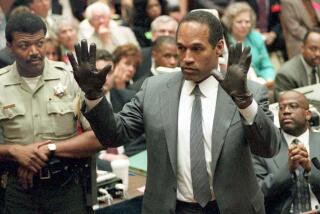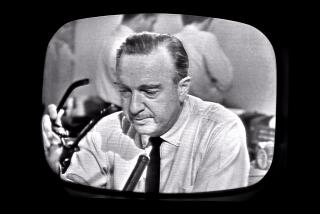92 Year in Review : The Cover Thing : The World in a Bloodshot Eye : TV disgorged the L.A. riots, a video that would not die, presidential politics and late-night turmoil. It was a year Kafka could love
- Share via
The year in review? As always, our approach to such an undertaking has been scholarly, relying entirely on empirical data. We’ve indexed, cross-indexed, Trendexed, Windexed and Malcolm X’ed.
Thus, only after a careful examination by our staff--including holding countless interviews, conducting surveys, poring over stacks of documents and exhaustively studying hours and hours of videotape--have we concluded that nothing happened vis-a-vis television in 1992.
Absolutely nothing, except:
The Story From Hell: The Los Angeles riots in April.
The fires, the looting, the violence, the chaos and the political and social complexities of this upheaval brought out the best and worst of TV news. It was live TV chopper coverage of the carnage at Florence and Normandie, for example, that provided a panoramic overview of what was happening, exposed police inaction and brought four African-Americans to the aid of battered white trucker Reginald Denny, saving his life.
It was also during this runaway coverage, however, that some anchors and reporters inadvertently provided a virtual road map for potential looters and made thoughtless and potentially inflammatory statements that affirmed both their own ignorance and the perils of live TV. In many cases, restraint was a stranger.
The riots demonstrated anew the value of TV technology when it comes to covering a breaking story. They also demonstrated that, if not accompanied by journalistic experience and good judgment, the technology can be destructive.
The Video That Just Kept Going. . .and Going. . .and Going: Amateur camcorder operator George Holliday’s footage of police beating motorist Rodney G. King.
Although shot in 1991, so horrifying were these grainy pictures that they understandably had a lingering profound impact on the entire nation, leading to the criminal trial in Simi Valley--the outcome of which became the catalyst for the Los Angeles riots. But once TV news producers gain access to dramatic footage, they attach themselves to it like bloodsucking leeches, and such was the case with the King video.
Newscast after newscast used it to wallpaper every story--even a brief item--that mentioned King’s name. In fact, the footage was repeated so often that it became almost routine, if not an abstraction, tending to desensitize you to what was happening on the screen no matter how much you were shocked and angered initially.
The power of pictures is enormous. So too is the capacity of TV to misuse them.
Has It Ended Yet?: Yes, and remember you read it here. The presidential election campaign is over, and it’s already time to start speculating about whom the Republicans will run in 1996.
One of these days, Americans will determine a way to shorten the grueling marathon presidential selection process and, as a bonus, put a cork in all the windy pundits and partisan spinmeisters who command the airwaves in election years. Whatever happened to pollution control?
Thanks in large part to Ross Perot and his prickly presence in presidential debates and his constant warring with the press, however, the 1992 campaign was a much better and more productive TV show than most. And also largely because of Perot, TV did a much better job of consistently addressing crucial issues.
In terms of TV, Perot may turn out to be a one-time-only blessing. But if there was one campaign phenomenon that promises to resonate beyond 1992, it’s the candidates’ discovery of radio and TV talk and phone-in shows as a means of bypassing media pests and communicating directly with the public.
In past campaigns set in the TV era, it was the print press that was relegated to the back of the bus. In 1992, print and electronic press alike were symbolically kicked off the bus.
A Few Good Marshmallows: That’s what presidential candidates were seeking when they faced talk-show hosts in 1992, and they got a big, squishy one in Larry King, whose CNN series did indeed provide them sanctuary from the tough questions that reporters are supposed to ask.
Although talk-show hosts correctly maintain that they are not journalists, this is an age in which they are sometimes called upon to act in that capacity, such is their influence.
Yet instead of being the adversary of George Bush, Bill Clinton and Ross Perot--a proper role for someone interviewing presidential hopefuls--King became their TV pal, befriending but rarely challenging them.
Two Sound Bites That Wouldn’t Die: Vice President Dan Quayle starred in one and co-starred in the other.
The first was Quayle’s public condemnation of the CBS sitcom “Murphy Brown” for promoting--his charge--single motherhood over the traditional family. In accusing his critics of distorting what he had said, Quayle himself distorted his original remarks. By that time, the feud between a vice president and a fictional TV character had become so absurdly surreal that the media began speculating about how Murphy Brown would respond.
Not very shrewdly, as it turned out, proving that Quayle’s speech writers were not the only ones guilty of overkill.
The second sound bite was of Quayle misspelling potato for schoolchildren in front of TV cameras.
At first it was funny. But after being rerun again and again and resonating in the monologues of every comic who faced a camera, it became annoying. And finally, after Quayle-bashers refused to let it fade away, indelibly imprinting his potatoe gaffe on the entire campaign, it became downright obnoxious. With all the fuss, you’d have thought he’d done something really terrible--like flashing in front of these kids or something.
How do you spell enuf ?
Another Sound Bite That Wouldn’t Die: Gennifer Flowers claiming at a televised press conference that she had a long-term affair with Clinton, a charge that she backed up only with a questionable audiotape, but one whose aftershock rumbled throughout the campaign and assumed a life of its own.
Many in the so-called legitimate press were lukewarm to the Flowers story but were forced to give it prominence when Clinton himself went on “60 Minutes” with his wife, Hillary, to issue a denial.
Ultimately for Flowers, it was not a very good year, given Clinton’s victory in the election. But everyone loves a juicy sound bite, so look for her to make a comeback in 1996.
The Cold Wind From the North: John Lippman, the KCBS-TV Channel 2 news director whose arrival from Seattle shoved the CBS-owned station’s already troubled news department into an abyss of shoddy journalism and plummeting morale. Lippman and his news staff are said to be about as compatible as Howard Stern and the Federal Communications Commission.
Because other home-grown production is virtually nonexistent, local news has become every station’s centerpiece--the big, looping signature by which it identifies itself to the public. And under Lippman--whose sleazy antics undoubtedly have the blessing of network management in New York-- BS have become the call letters most identifiable in KCBS newscasts. Accordingly, “Action News” has increasingly become the butt of jokes and public anger while acquiring the soul and trappings of a frizzed, rouged-up streetwalker, with tabloid-style deception and gimmicky “live” coverage becoming its main components.
With Lippman having driven off many of his most skilled people, his main achievement so far has been in payroll reduction. Yet, this is a business driven by profits. So if he is ever able to translate his lowbrow philosophy into significant ratings, “Action News” may become a local news prototype for the ‘90s.
Brother, Can You Spare a Dime?: Those deep pockets at KNBC-TV Channel 4 hired KABC-TV Channel 7 anchor Paul Moyer at an estimated $1.4 million a year while maintaining that the cash outlay would not force budget cuts in other areas of its news operation. Well, the ever-weaker news product that Channel 4 puts out speaks for itself.
Personalities are the very underpinning of most of TV news. Pushing that to an irrational apex, though, Channel 4 has treated Moyer as if he were a matinee idol whose face alone would make viewers swoon and dramatically increase Channel 4’s audience. So far, the only thing Moyer has increased is Channel 4’s payroll.
L.A.’s Masterpiece Theatre: “Life & Times” has been just that since surfacing nearly a year ago on KCET-TV Channel 28. The weeknight program’s current mix consists of three studio-discussion editions and two documentary nights, which collectively present a picture of Los Angeles far richer and more diverse than is available anywhere else on local television.
“Life & Times”--at its very best when studio hosts Hugh Hewitt, Ruben Martinez and Patt Morrison hash over topics themselves or with their guests--is a role model for the city’s commercial stations, whose concept of socially responsible local programming is news about crime and gore.
Several Sizes Too Small: That describes the season’s most deficient new series, “The Hat Squad.”
Worse by far even than Fox’s “Melrose Place” and NBC’s “Round Table,” “The Hat Squad” is a comically bad CBS drama that follows the adventures of three pinheaded young undercover cops who dote on their stepparents and wear old-fashioned snap-brim hats. Why? One can only speculate.
Because the hats cover lobotomy scars?
Here’s. . .??????: Johnny Carson’s “Tonight Show” abdication placed Jay Leno on the 11:30 p.m. throne that David Letterman wanted to occupy. So Dave may show up on CBS at 11:30, facing Jay and the second half of Arsenio Hall’s syndicated talk show, having reportedly already rejected an offer from Fox, which is readying Chevy Chase for a late-night talk show, which possibly would air opposite a 12:30 p.m. Dana Carvey show on NBC should he succeed Dave there if Dave moves to CBS, which, if it is really smart, would lure Johnny out of retirement so that he could challenge Jay, which may appeal to Johnny in view of Jay’s failure to acknowledge Johnny’s greatness when he took over for Johnny amid rumors that Ted Koppel’s new substitute host on “Nightline” would be Henny Youngman.
Take them all . . . please .
More to Read
The complete guide to home viewing
Get Screen Gab for everything about the TV shows and streaming movies everyone’s talking about.
You may occasionally receive promotional content from the Los Angeles Times.






